The Magnificent Maasai of East Africa
Written by
Ker & Downey® Africa
A Maasai of East Africa, clad in his trademark traditional dress, walks alone on the white sand beach towards me, his bright red shuka contrasting strikingly with the bright turquoise of the Indian Ocean in the background. We cross paths and he flashes me a wide, toothy smile, his kind eyes looking deeply into mine, before greeting me warmly, “Karibu Unguja!” – ‘Welcome to Zanzibar’. I nod and smile in response to this simple yet heartfelt interaction, and the next thing I know, we are talking in beautiful broken english about the magnificence of the island, and how we both came to be there. He invites me to visit his nearby village the following day to see the market and I oblige eagerly, before watching him gently continue on his way, his shuka swaying in the breeze, his presence calm and courageous.
This was my first interaction (of many) with a Maasai in East Africa, and it was a moment I will never forget. A moment of depth, warmth and connection that took my travel experience to a whole new level of meaning.
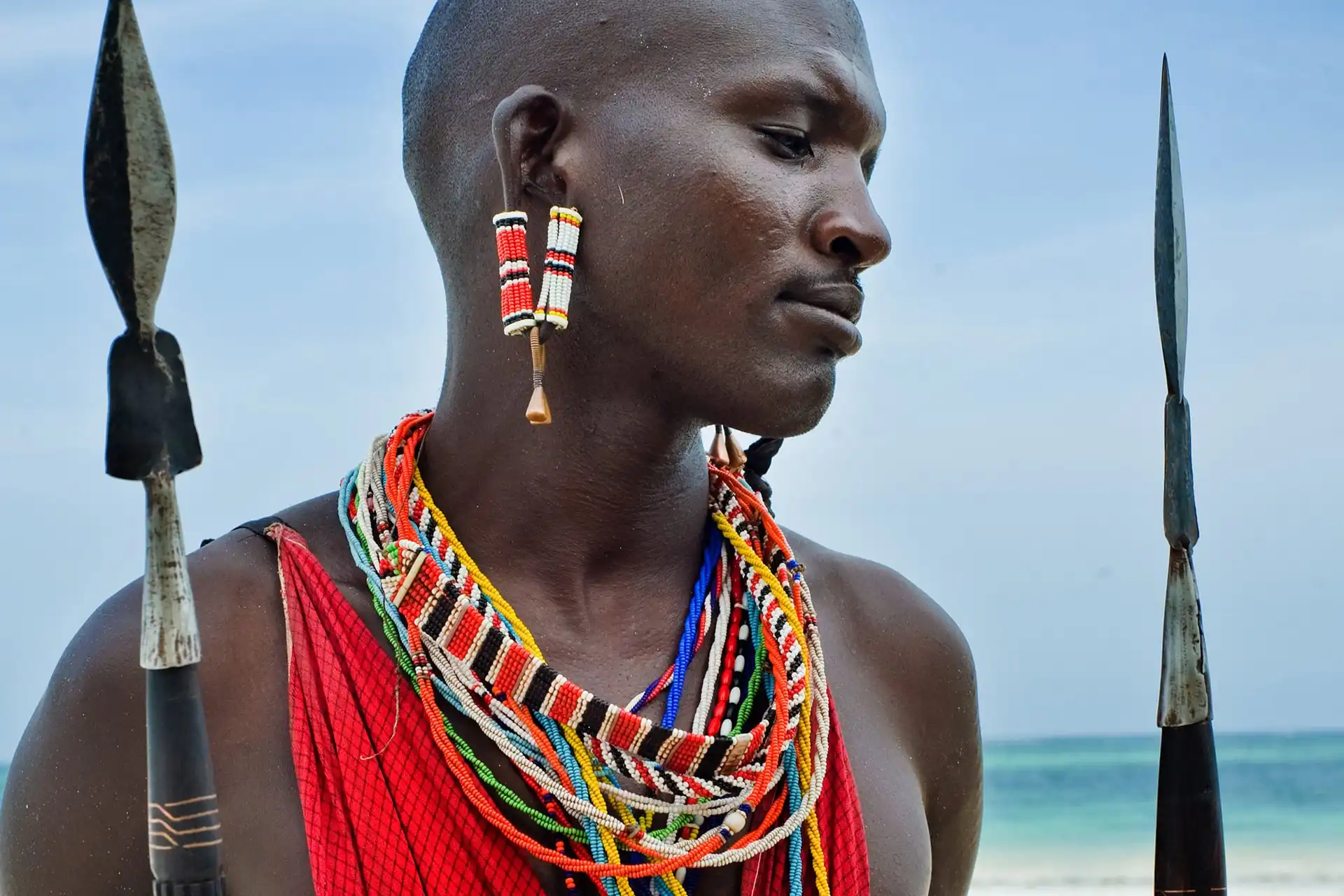
A Maasai warrior on the beach in Zanzibar
The History of the Maasai
The bright red-clad Maasai of Tanzania and Kenya – like the iconic wildlife that roam the plains – are synonymous with the savannahs of East Africa. They are widely-known and revered symbols of the region who, for hundreds of years, have carved the landscape since their migration from South Sudan during the late 17th and early 18th centuries. The Maasai thrived in Southern Kenya and Northern Tanzania until the mid-19th century when smallpox, drought, starvation and animal disease wiped out almost 60% of the people and killed almost all of their cattle.
The darkest days were over in the early 20th century however. Although the population began thriving once again, vast sections of the land were being turned into wildlife reserves and national parks, with governments putting increasing pressure on the Maasai tribes to give up their semi-nomadic lifestyles and become farmers. The majority of the Maasai resisted the pressures of the Tanzanian and Kenyan governments to adopt a more sedentary lifestyle, and remain on the land to this day where they can be seen in their colourful robes herding cattle, and coexisting in peace with their natural surroundings.
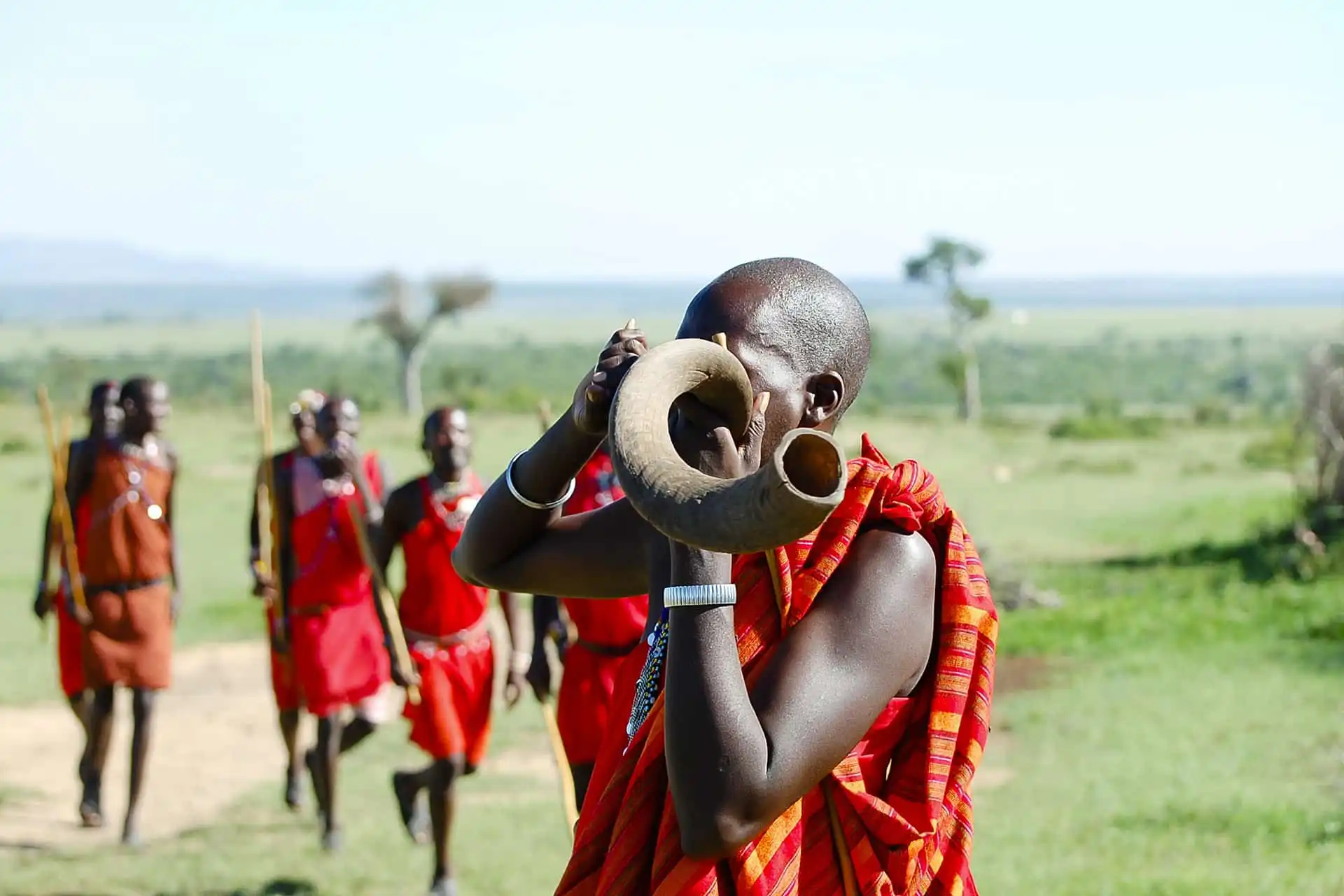
A traditional Maasai warrior blowing a Kudu horn
The Maasai as Pastoralists and Warriors
Despite the initial pressures to give up their way of life, the Maasai have fought to preserve their culture and many traditions and practises remain unchanged. They have a fearsome reputation as warriors, and are renowned pastoralists who view cattle as sacred after the first-ever Maasai named, Maasinta, received a gift of cattle lowered down to earth from the rain god, Ngai. The semi-nomadic lifestyle of the Maasai centres around the cattle who are seen not only as a valuable and primary source of food, but also as a measure of value, akin to children. The bigger the herd and family, the more successful the man. Having a large amount of one, but not the other, a man is considered poor.
As warriors, the Maasai are widely respected by their African counterparts and, up until now, the only way for a young Maasai boy to achieve warrior status was to kill a lion single-handedly with his spear, in a bloody rite of passage ceremony. Lion hunting also used to be a way for warriors to express their courage and bravery, become leaders in the tribe, and attract girlfriends. Nowadays, with conservation playing a large role in the preservation of this pivotal African mammal, lions are only rarely killed, and Maasai warriors are seen showing off their warrior skills and athleticism instead to demonstrate their abilities.

A traditional Maasai Village
Popular Maasai Customs and Traditions
- The traditional language of the Maasai is called ‘Maa’ and is spoken but not generally written. In fact, the name ‘Maasai’ itself means ‘people who speak Maa’.
- The bright colours of the Maasai cloth, beads and other adornments are all very symbolic: the vibrant red coloured cloth represents blood and is the symbol of bravery. It is the primary colour of all the shukas worn. Blue represents the sacred sky and rain that provides sustenance and graving for the cattle; green subsequently represents the grass and nourishment; orange is symbolic of their warmth, friendliness and openness; yellow is the colour of fertility, and white is the symbol of peace.
- A stereotypical image people have of a Maasai warrior is a tall man, jumping in a trance-like state for hours, clutching his spear in one hand. This jumping dance is called the Adumu and is performed as part of the initiation rite when young boys become men, and ultimately, warriors. There is a competition that takes the place of lion hunting to see who can jump the highest. This ritual shows fitness and athletic prowess and is also performed to attract a partner. As each man jumps, the others sing a high-pitched song with the tone changing depending on the height of the jump.
- The Maasai are known to drink cow’s blood, which they mix with the milk, as a form of nourishment to make the body stronger. It is believed to be very good for children and the elderly, and is a supplement for consuming meat, which is reserved for special occasions only. The blood is drawn from the jugular vein of the cow by the insertion of a small arrow. The cow is then very carefully tended to and looked after until the small wound heals, with the Maasai making every effort to not harm their sacred bovine companions.
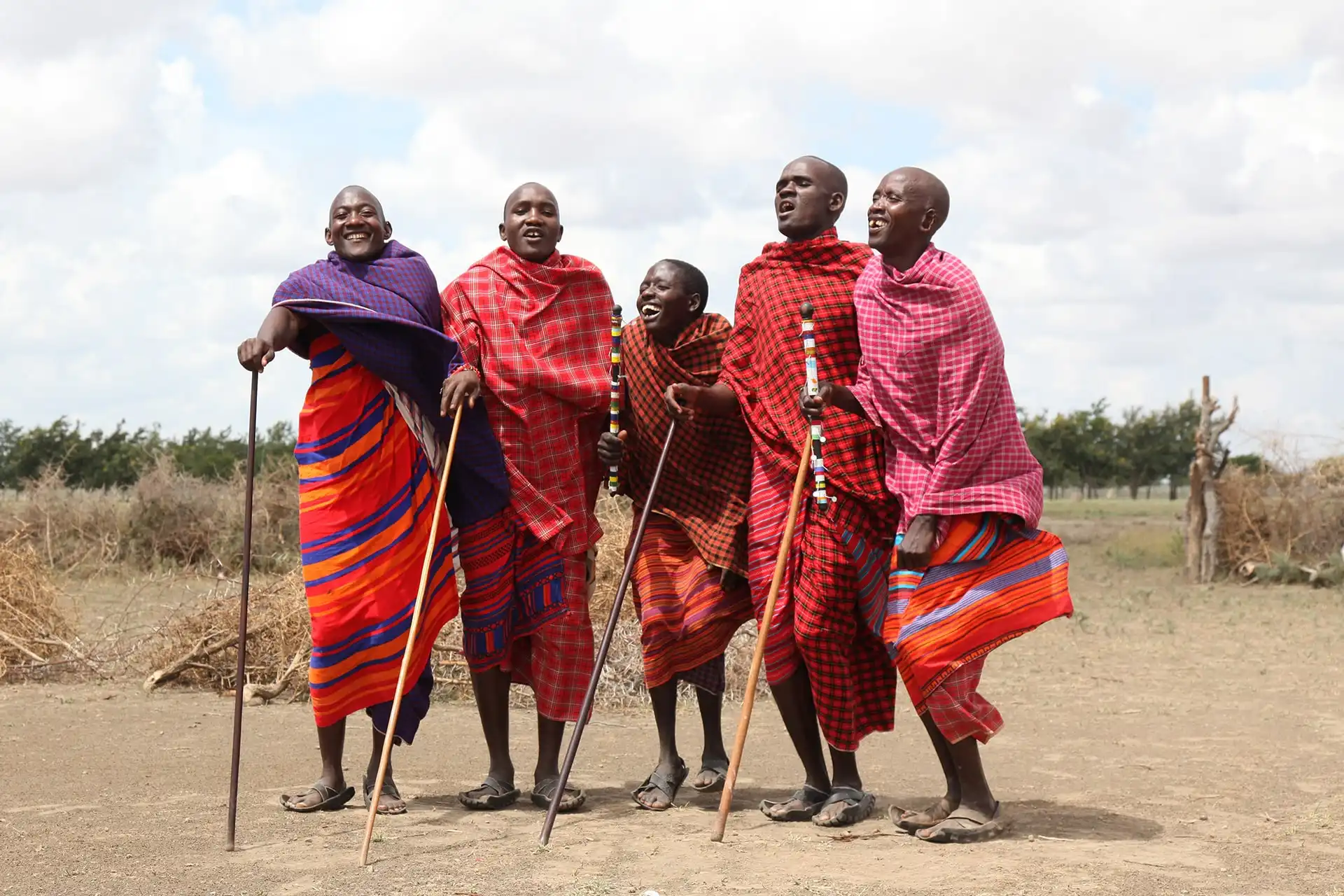
A group of Maasai men singing
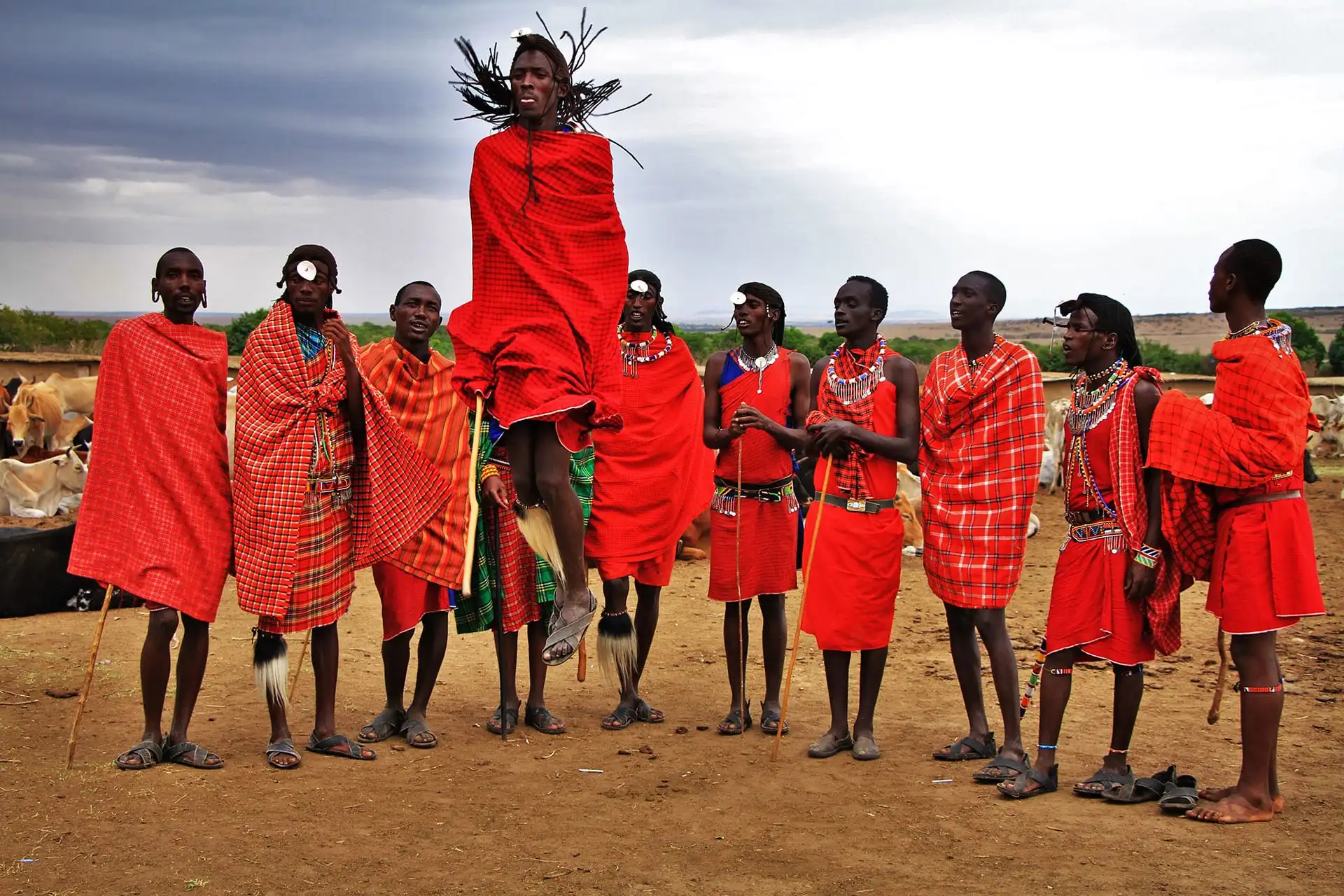
A Maasai man performing the Adumu dance
The Maasai make up a large part of the East African landscape between Kenya and Tanzania, particularly in and around the Serengeti, Ngorongoro, and Kenya’s Masai Mara National Park. Because of this, a visit to a local Maasai village is a popular activity during a trip to East Africa and is as unforgettable as witnessing the incredible landscapes and wildlife that make up the region.
A cultural safari with Ker & Downey® Africa invites travelers to discover new cultures and learn the customs of the indigenous people who have shaped the African landscapes for centuries. Our team has crafted a set of sensitive, culturally aware itineraries that directly benefit local communities like the Maasai, and enable you to leave a lasting legacy in this truly rich part of the world.
Lodges in East Africa that offer Maasai Experiences
Entamanu Ngorongoro, Tanzania
Situated off the beaten track, in the heart of Maasai territory, Entamanu Ngorongoro offers an authentic glimpse into the culture. Meeting the Maasai while staying here is an enriching, fascinating and genuine experience.
Lemala Mpingo Ridge, Tanzania
Lemala Mpingo Ridge is situated on top of an escarpment, with expansive views of the perennial Tarangire River. The lodge offers guests a memorable opportunity to interactively experience the Maasai way of life through an excursion to a traditional boma.
Mara Plains Camp, Kenya
One of only five camps located within the 35,000 acre Olare Motorogi Conservancy, Mara Plains Camp borders the Masai Mara Reserve with unrivalled access to the private conservancies that surround it. If a chance to learn about the Maasai is of interest, then cultural visits to a nearby Maasai village (locally known as an “enkang”) is a highlight.
Governor’s Camp, Kenya
Governors’ Camp is just a short boat ride across the famous Mara River within a riverine forest. There is a local community nearby called Mara Rianda which consists of 48 traditional houses surrounding a cattle enclosure. If you would like to experience a way of life unchanged for centuries, a visit here is life-changing.
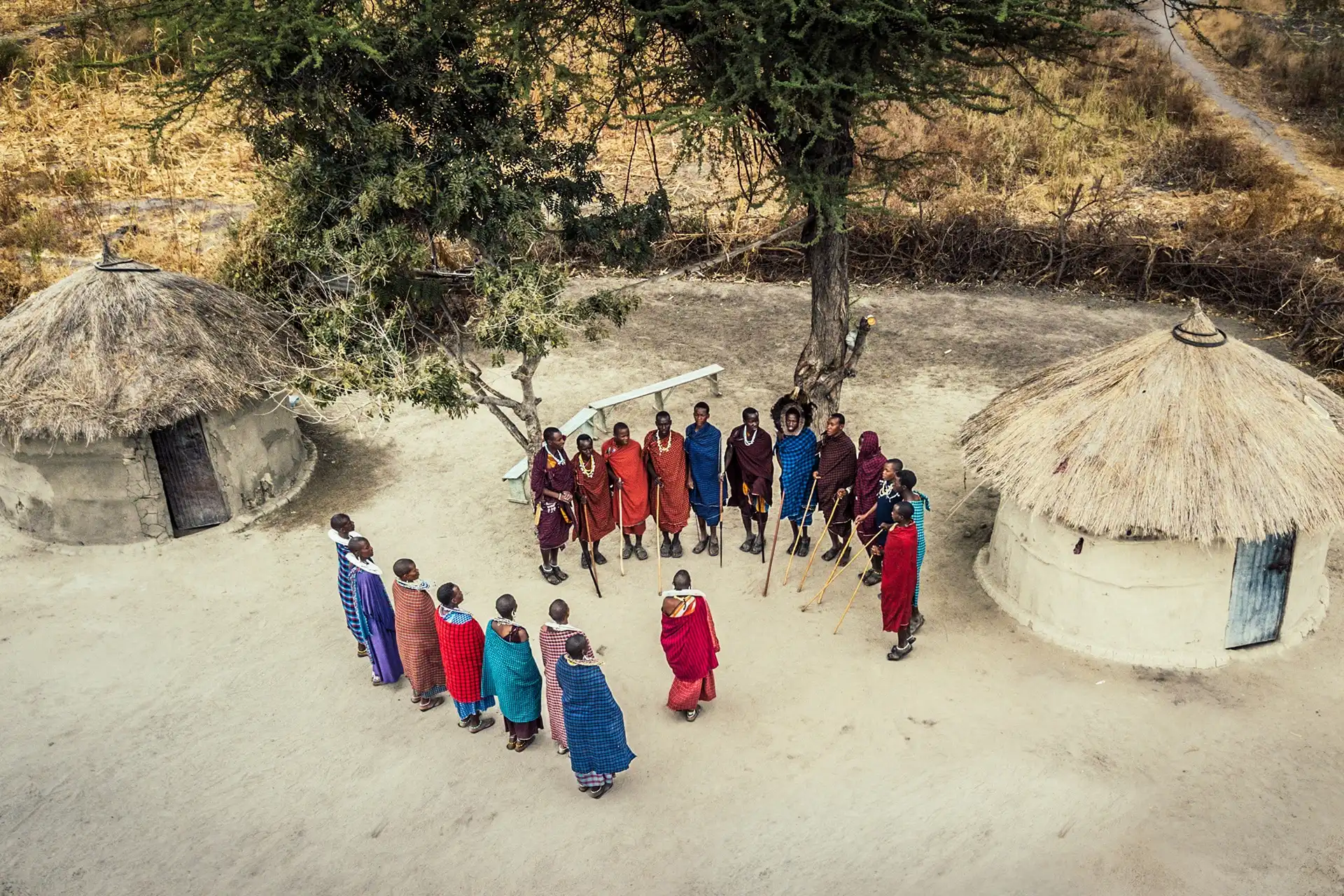
A cultural village to a local village at Lemala Mpingo Ridge
Curated Packages
Signature journeys across Africa
Our expert team crafts journeys that transcend luxury. Each itinerary is shaped by the spirit of the land and the wisdom of its people — opening doors to experiences few can imagine, and even fewer will ever access.
June-October
|
7 DAYS
African Wild Dog Safari
From
per person
June-February
|
13 DAYS
A Cultural Safari Tanzania Zanzibar
From
per person
All Year Round
|
13 DAYS
Amboseli, Lewa and Masai Mara Safari
From
per person
Jan, Feb, Jun – Sept
|
5 DAYS
Mountain Gorilla Trekking in Rwanda
From
per person
All Year Round
|
12 DAYS
South Africa Art, Wine & Wilderness Safari
From
per person
All Year Round
|
12 DAYS
Tanzania & Zanzibar Honeymoon Safari
From
per person
All year round
|
9 DAYS
9-day Victoria Falls to Botswana Luxury Safari
From
per person
June - Sept
|
11 DAYS
Uganda Done Right
From
per person
June - Sept
|
15 DAYS
Gorillas & Big Five Safari Adventure
From
per person
All Year Round
|
8 DAYS
Fly-in Luxury Namibia Safari
From
per person
March-December
|
10 DAYS
Luxury Private Safari in Zambia
From
per person
June-October
|
9 DAYS
Sub Saharan Kenya Safari Experience
From
per person
All Year Round
|
11 DAYS
Luxury Egypt Experience
From
per person
June - Sept
|
8 DAYS
Rivers & Rainforests: A Ugandan Safari
From
per person
March to June
|
10 DAYS
Zimbabwe Victoria Falls & Safari LuxVenture®
From
per person
All Year Round
|
8 DAYS
Best of Egypt LuxVenture®
From
per person
All Year Round
|
10 DAYS
Tanzania & Zanzibar Family Holiday
From
per person
All year round
|
12 DAYS
Luxury Family Safari: South Africa & Victoria Falls
From
per person
All year round
|
9 DAYS
Beaches of Seychelles Vacation
From
per person
All Year Round
|
14 DAYS
Luxury South Africa and Mozambique Honeymoon
From
per person
Dec – Mar
|
7 DAYS
Wildebeest Calving Season Safari
From
per person
June-August
|
12 DAYS
Rovos Rail and Zambezi River Escape
From
per person
All Year Round
|
8 DAYS
Luxury Kenya Safari
From
per person
All Year Round
|
9 DAYS
Botswana Okavango Honeymoon LuxVenture®
From
per person
May to October
|
8 DAYS
Mad Max Safari Adventure
From
per person
All Year Round
|
10 DAYS
Luxury Tanzania Honeymoon LuxVenture®
From
per person
All Year Round
|
7 DAYS
Luxury Gorilla Trekking Safari in Rwanda
From
per person
June-October
|
10 DAYS
Electric Vehicle Safari in Kenya
From
per person
April-October
|
10 DAYS
Best of Botswana Safari
From
per person
All Year Round
|
13 DAYS
Elephant Safari in South Africa, Victoria Falls & Botswana
From
per person
June – October
|
18 DAYS
Tanzania and Seychelles Luxury Safari
From
per person
June-October
|
9 DAYS
The Great Wildebeest Migration Safari in Tanzania
From
per person
All Year Round
|
9 DAYS
Luxury Safari in Kruger National Park & Cape Town
From
per person
All Year Round
|
17 DAYS
Southern Africa: Framed and Untamed
From
per person
May to October | November to April
|
11 DAYS
Spirit of Zambia Safari
From
per person
All Year Round
|
11 DAYS
Cape Town Safari & Whale Coast Adventure
From
per person
Year Round
|
10 DAYS
Natural East Africa Wonders Safari
From
per person
All Year Around
|
12 DAYS
Tanzania and Zanzibar Safari
From
per person
Feb – May, Sep – Dec
|
10 DAYS
Luxury Journey Through Morocco
From
per person
All Year Round
|
Day Trip to Antarctica LuxVenture®
From
per person
All Year Round
|
12 DAYS
Stargazing Desert Safari in Namibia
From
per person
All Year Round
|
10 DAYS
Cairo + Luxury Nile Cruise
From
per person
Jan, Feb, Jun – Sept
|
13 DAYS
Gorilla Trekking, Ngorongoro Crater & Serengeti
From
per person
May-October
|
8 DAYS
Luxury Treehouse Safari to Botswana LuxVenture®
From
per person
All Year Round
|
12 DAYS
Culinary Journey to Morocco
From
per person
All Year Round
|
9 DAYS
‘Out of Africa’ Safari in Kenya
From
per person
July-September
|
6 DAYS
Horseback Safari in Kenya
From
per person
Year Round
|
15 DAYS
The Ultimate Southern Africa Bush & Beach
From
per person
Year Round
|
18 DAYS
Southern Africa Luxury Bush & Beach Escape
From
per person
June-October
|
8 DAYS
Tanzania Northern Circuit Safari
From
per person
All Year Round
|
14 DAYS
Southern Africa’s Finest: SA, Victoria Falls & Botswana
From
per person
All Year Round
|
17 DAYS
Luxury Mauritius & South Africa Experience
From
per person
15 June - 15 November
|
7 DAYS
Luxury Tented Safari in Tanzania
From
per person
All Year Round
|
7 DAYS
Chobe River Cruise & Okavango Delta Safari
From
per person
All Year Round
|
10 DAYS
Botswana & Victoria Falls Adventure
From
per person
All Year Round
|
16 DAYS
Ultimate East Africa Safari
From
per person
All Year Round
|
11 DAYS
Luxury Safari in Zambia
From
per person
Year Round
|
11 DAYS
Luxury Seychelles Honeymoon and Couples Vacation
From
per person
All Year Round
|
6 DAYS
Luxury Morocco Vacation
From
per person
May-October
|
10 DAYS
South Luangwa Walking Safari
From
per person
Year Round
|
8 DAYS
African Wild Dog Safari in Zimbabwe
From
per person